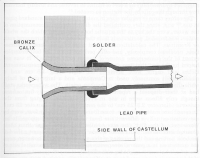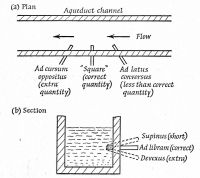


Fontinus about calices:
|
Pressure
Frontinus supplies a great deal of information on the methods by which supplies were measured and assessed for tax. Here we meet the contrast between the understanding of the statics, and the lack of understanding of the dynamics. No attempt seems to have been made to measure the speed at which water flowed through a pipe or conduit. The entire technique seems to have been based on the size of the calix. Why this is is not known.The rate of flow of each aqueduct was calculated in quinariae. It is an impossible task to determine exactly what a quinaria was, but scholars have calculated that - under vertain conditions - one quinaria was something equal to 0.48 liters/second.
The Romans certainly had some knowledge of water pressure. For example, it was known that if the gradient of the channel was steeper, the speed of the flowing water would increase. Vitruvius also discusses pressure in reference to inverted siphons. Frontinus makes no attempt to explain this. Under normal circumstances a pipe of a specific size delivers a certain amount of water to a customer, but in the case of a steeper channel or extra rain in the catchment area more water than normal would be delivered (Landels, 2000:49). This seems to be simply regarded as a bonus for the recipient of the water. Frontinus does write of making some adjustment if the rate of flow differs from the normal (35):
Let us remember that every stream of water, whenever it comes from a higher point and flows into a reservoir after a short run, not only comes up to its measure, but actually yields a surplus; but when ever it comes from a lower point, that is, under less pressure, and is conducted a longer distance, it shrinks in volume, owing to the resistance of its conduit; and that, therefore, on this principle it needs either a check or a help in its discharge.Frontinus also recognises that the position of the calix is important, not just the size. He states (1.36):
But the position of the pipe is also a factor. Places at right angles and level, it maintains the normal quantity. Set against the current of the water, and sloping downward, it will take in more. If it slopes to one side, so that the water flows by, and if it is inclined with the current, that is, less favourably placed for taking in water, it will receive the water slowly and in scant quantity.Frontinus takes a number of pages to describe all the standard sizes of pipes in detail. He (37) states that of the 25 available, only 15 are in use.